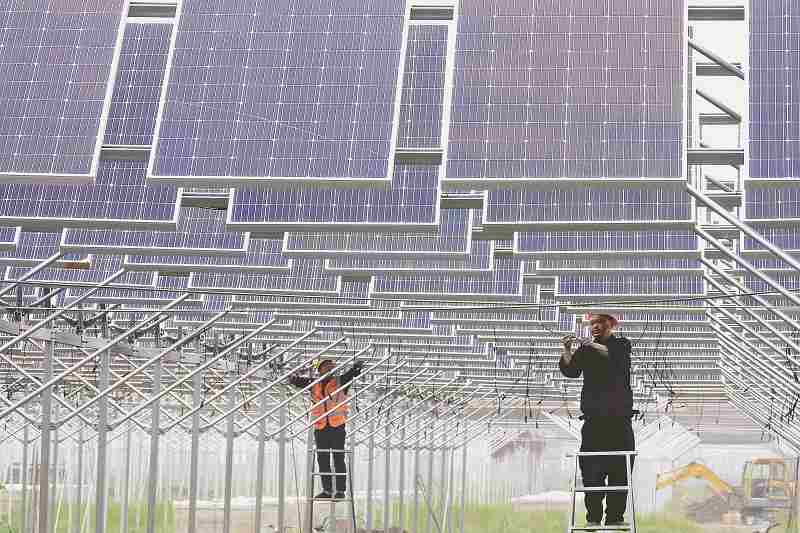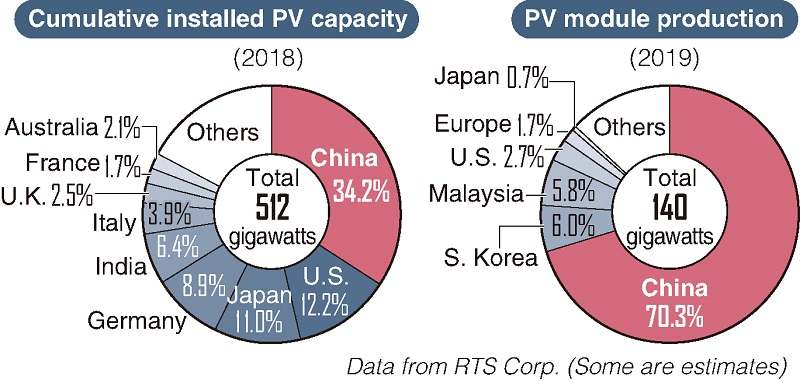
Workers install solar panels in Lianyungang, Jiangsu Province, China, in May 2018
10:57 JST, June 28, 2021
Solar power is seen as a leading alternative energy source on the road toward a decarbonized society. But the sun has long since set on the U.S.’s once-vibrant solar industry and the highly-competitive Japanese companies who shone there, eclipsed by the rise of Chinese firms that now dominate the market. Shumpei Takemori, a specialist in international economics, offers his insights into the factors behind this wax and wane of solar fortunes.

Green panels on the White House
In 1979, then-U.S. President Jimmy Carter installed 32 solar panels on the roof of the White House as a symbol of his goal for solar power to account for 20% of the nation’s energy needs by the year 2000.
At the dedication ceremony, Carter declared: “A generation from now, this solar heater can either be a curiosity, a museum piece, an example of a road not taken, or it can be a small part of one of the greatest and most exciting adventures ever undertaken by the American people — harnessing the power of the sun to enrich our lives as we move away from our crippling dependence on foreign oil.”
More than 40 years later, the verdict is still out on Carter’s environmental policy, and the U.S.’s approach to decarbonization has proved inconsistent.
In the words of Carter’s successor, President Ronald Reagan: “Government is not the solution to our problem, government is the problem.” When Reagan moved into the West Wing, he pulled the plug on Carter’s environmental incentives and took down the solar panels from the roof.
Whereas the current President Joe Biden has said that the U.S. will decarbonize by 2050, his predecessor Donald Trump withdrew from the international Paris climate agreement.
This lack of predictability has also been evident in the country’s private sector. U.S. oil giant Exxon Mobil Corp.’s decision to fill a handful of seats on its board with directors who support decarbonization at the end of May has compelled institutional investors and capital markets to follow suit by going green. But this may prove to just be the latest “green rush” of many that have come and gone in the past.
Sharp fall in investment
The previous green rush occurred between 2006 and 2011. In the United States, solar power opened the gates to a deluge of startups and venture capital. But after the boom went bust, many of these players went bankrupt. The bust was compounded by two factors. First, this period coincided with the final stage of the U.S. housing bubble. When the housing bubble collapsed, the blow-off triggered the Lehman crisis, curbing all appetites for investment, and especially inviting a sharp decline in investment in new sectors such as solar power.
Secondly, after suffering heavy blows in the Lehman debacle, China redoubled its public investment. Solar power was designated as a strategic industry and supported with low-interest loans. As a result, Chinese solar batteries, which accounted for only 2% of the global market in 2003, grew to represent a 60% share by 2011.
Unlike fossil fuels, renewable energy sources such as solar and wind are free in terms of raw material cost, but require massive capital investment in equipment. As a result, it becomes imperative to make use of economies of scale, leveraging mass production to lower the investment cost relative to each unit of power generated.
By scaling up production, China was able to reduce solar power generation costs by 80% in the 2010s, making solar an inexpensive energy source. Meanwhile, China’s low-price offensive undercut the U.S., decimating America’s domestic solar battery production.
Systemic competition
The solar sector has traced a typical of today’s industrial leaders, progressing through the stages from the United State’s verve for development to Japan’s manufacturing acumen and now on to China’s low prices.
After being sparked by Bell Labs in 1954, solar became the playground of startups led by U.S. university researchers in the 1970s as oil prices soared.
Japanese companies burst onto the scene in the 1990s, developing residential photovoltaic (PV) systems supported by the then International Trade and Industry Ministry’s New Sunshine Project (see below). By 2005, Japan accounted for about half the world’s solar cell production, and four of the world’s top five producers were Japanese manufacturers: Sharp Corp., Kyocera Corp., Sanyo Electric Co. and Mitsubishi Electric Corp.
But as China rose, many Japanese companies dropped out. The retreat was partly due to the cash-strapped Japanese government’s decision to end a program that had been buying back electricity generated by private homes at a favorable fixed price. Japan’s Achilles heel, however, would prove to be the government’s failure to institute systems capable of facilitating power generation on a large-scale.
At the outset, Japanese companies hitched their carriage to highly-efficient solar cells with a high price tag to match. By contrast, Chinese companies have focused on inefficient yet cheap cells.
Although conducive for small-scale residential installation, Japanese solar cells proved unsuitable for laying out by the thousands in arrays needed to produce large volumes of energy. In the mid-2000s, Europe began championing renewable energy in earnest. As specialized solar power companies cropped up worldwide, expensive Japanese services were priced out of the market.
Japanese makers’ disinclination to developing specialized solar panes can be traced back to infrastructural problems in the nation’s power system. The separation of power generation businesses from transmission businesses has advanced amid the gradual liberalization of the electric power sector from 1995 on. Even so, old habits die hard, and management has tended to prioritize transmission of electricity generated by their own companies.
In a power ecosystem that gravitates around thermal and nuclear generation, electric power companies have eyed solar and wind as an unwelcome intruder. The bulk of solar power is naturally generated during daylight hours; in order to transmit solar power during this key window, companies have to reduce their thermal power output. If power companies begrudge making these capacity adjustments, specialized operators will struggle to find footholds to enter the renewable energy business.
Two hurdles
Japan’s offshore wind power generation is also said to be 20 years behind industry-leading Europe, despite favorable environmental conditions with strong winds blowing in from the Chinese continent. In Japan, solar power is still mainly for residential use, and large-scale power generation involving specialized operators is almost nil.
Therein lies the rub.
Fundamental systemic reform of the electric industry is needed to bolster renewable energy on the road toward decarbonization. Specifically, the government must make a clean break in separating the power generation and transmission businesses, while also reconstructing the nation’s approach to power generation itself, giving precedence to renewable energy sources over thermal power.
In order to advance the cause of solar power generation, the nation will need to clear two hurdles.
First, this mountainous island nation has little flat terrain. Large-scale solar panel installation will have to take place in mountainous areas, entailing significant capital investiture.
Second, domestic industry will have to find a way to push back against China’s overwhelming competitive advantage when it comes to solar cells. From a broader perspective, Japan’s next task is to consider how its free market — reliant as it is on fickle market sentiment and democratic politics — could counter the bottomless public subsidies available for energy in China’s development dictatorship, in an industry predicated on economies of scale.
Ultimately, Japan may need to pivot from solar power, which constitutes the nation’s main source of renewable energy, to offshore wind power. Joint wind projects already underway in partnership with leading European companies in Hokkaido and the Tohoku region — areas boasting a high-concentration sites suitable for offshore wind power generation — merit close attention going forward.
The Sunshine Project
A national project launched by Japan in 1974 after the first oil crisis to develop new energy technologies in collaboration across industry, government, and academia. Research explored the use of solar, geothermal and hydrogen energy, as well as coal liquefaction and gasification. In 1978, a Moonlight Project was initiated to develop energy-conserving technologies, and in 1993, both initiatives were merged under the banner of the New Sunshine Project.
Peofile
Takemori, 65, is chairman of Mitsubishi UFJ Research and Consulting Co. and a senior fellow at the Research Institute of Economy, Trade and Industry. A specialist in international economics, he taught as a professor at Keio University until March 2021. He currently serves as a private sector member of the government’s Council on Economic and Fiscal Policy.
"World" POPULAR ARTICLE
-

8 Japanese Nationals Stranded on Indonesia’s Sumatra Island
-

Mozambican Cooking Class Held in Matsuyama, Ehime Pref.; Participants Don Aprons, Bandanas Made from Traditional Mozambique Fabric
-

U.S. Senate Resolution Backs Japan, Condemns China’s Pressure
-

China to Impose Sanctions on Shigeru Iwasaki, Former Head of Japan’s Self-Defense Forces, Who Serves as Adviser to Taiwan’s Executive Branch
-

South Korea’s Top Court Dismisses Nippon Steel Appeal in Lawsuit over Requisitioned Worker
JN ACCESS RANKING
-

Tokyo Economic Security Forum to Hold Inaugural Meeting Amid Tense Global Environment
-

Keidanren Chairman Yoshinobu Tsutsui Visits Kashiwazaki-Kariwa Nuclear Power Plant; Inspects New Emergency Safety System
-

Imports of Rare Earths from China Facing Delays, May Be Caused by Deterioration of Japan-China Relations
-

University of Tokyo Professor Discusses Japanese Economic Security in Interview Ahead of Forum
-

Japan Pulls out of Vietnam Nuclear Project, Complicating Hanoi’s Power Plans






















